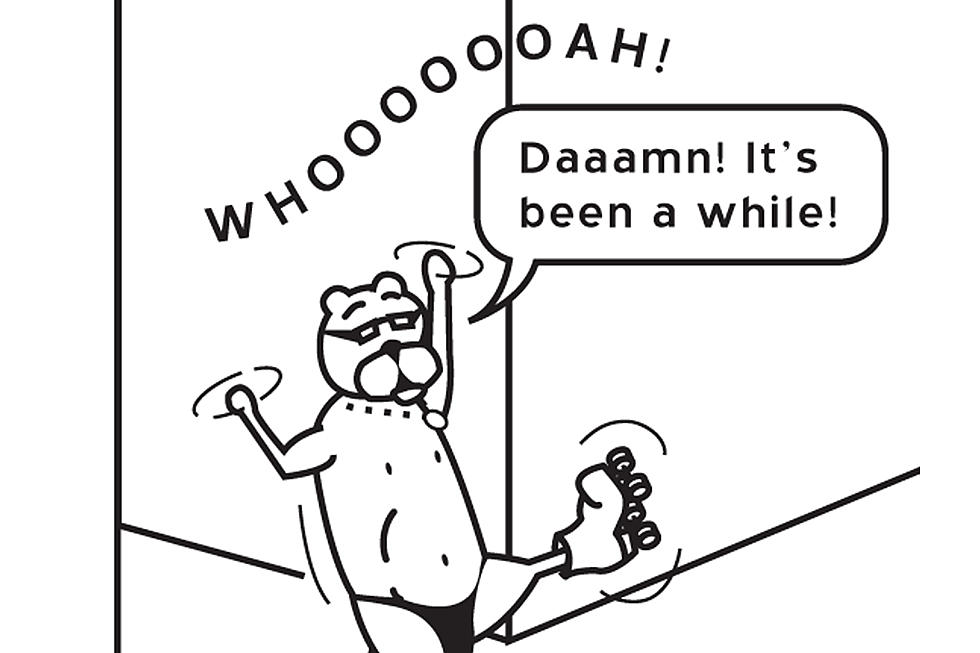
‘The Hunger Games’ is the Young Adult Fantasy Version of Achewood’s ‘The Great Outdoor Fight’

Last weekend, I joined the rest of America in going to see The Hunger Games. I haven't read the original novel, but I have to say that I really enjoyed the movie. The plot was compelling, the characters were engaging, and the setting had a great visual aesthetic that made it a really enjoyable film to watch. I've heard a lot of comparisons to Koushin Takami's Battle Royale, but since I haven't read that either, I'm not really qualified to judge. That said, there was one thing that Hunger Games definitely reminded me of.
Chris Onstad's Achewood and The Great Outdoor Fight.  For those of you who, like me, managed to somehow dodge a best-selling pop culture phenomenon, here are the basics of The Hunger Games as I understand them: After an unspecified and catastrophic war, the remains of North America are divided into twelve districts, each dedicated to a specific purpose to keep society running. Our heroine, for example, is from District 12, meaning that like Loretta Lynn, she was born a coal miner's daughter. The districts are ruled over by the evil President Donald Sutherland, whose sinister, decadent government believes that the best way to keep the peasantry in line is to kill off their children every year in a televised bloodsport. Amazingly, nobody in the entire government seems to think this might lead to a problem.
For those of you who, like me, managed to somehow dodge a best-selling pop culture phenomenon, here are the basics of The Hunger Games as I understand them: After an unspecified and catastrophic war, the remains of North America are divided into twelve districts, each dedicated to a specific purpose to keep society running. Our heroine, for example, is from District 12, meaning that like Loretta Lynn, she was born a coal miner's daughter. The districts are ruled over by the evil President Donald Sutherland, whose sinister, decadent government believes that the best way to keep the peasantry in line is to kill off their children every year in a televised bloodsport. Amazingly, nobody in the entire government seems to think this might lead to a problem.
The bloodsport in question is, as you might expect, the Hunger Games. Two children, a boy and a girl between the ages of 12 and 18, are selected from each district to fight to the death after four days of training. The contestants are selected by a lottery, and in the more destitute districts, you can get extra food by entering your name multiple times. But, and this is key for the story, you can also volunteer. Which is, of course, what happens when young Katniss Everdeen steps in so that her little sister won't be dragged off to get decapitated by a dude named, I kid you not, "Marvel."
Thus, Katniss is whisked away to be trained for battle by Woody Harrelson, and -- Spoiler Warning for the entire rest of this column! -- she ends up winning. Sort of. But we'll get back to that in a second.

On the flip side of things, we have The Great Outdoor Fight, the biggest and best story arc of Chris Onstad's long-running webcomic, Achewood -- and my pick, hands down, for the single greatest comic of the 21st Century. If you haven't already, you can read the story online starting here -- yes, the strip about TruckNutz -- but the hardcover from Dark Horse is well worth picking up for the incredible bonus features and extra strips that are included.
The story revolves around the event in the title, a massive, annual brawl involving three acres and three thousand men. Ray Smuckles, Achewood's de facto main character, finds out that his father won the Fight back in the '70s, and decides to enter it himself:

It seems like a pretty simple premise, and it definitely leads to some of Achewood's signature brand of character-based comedy, but it goes further than that. By the end of it, the story is equal parts action, comedy and drama, dealing with what friendship truly means to the characters, and the idea of a man trying to live up to the impossible legend of his absent father. It even culminates in a moment where the main character breaks free of the oppressive existing order and instead triumphs through his own individuality. Which, if you're familiar with Hunger Games, is probably where things start to sound familiar.
Obviously, the two stories have a lot of differences. For one thing, the Hunger Games has a much smaller cast of combatants, 24 to GOF's 3,000 brawlers. Also, the Hunger Games are a mandatory construct of a dystopian government with a terrifying risk and a lucrative reward, whereas the GOF is a voluntary proving ground for would-be tough guys whose only reward is the bragging rights that come from beating down 2,999 other people. While both stories are concerned with relationships, The Hunger Games develops a romantic subplot, while Achewood focuses on friendship.
And, perhaps most tellingly, The characters in The Hunger Games are not anthropomorphic cats.

But there are undeniable similarities in the way that the two stories are presented, both in terms of the overarching themes -- like the way both characters are motivated by family, and the impending threat of the GOF's Jeeps or The Hunger Games' genetically engineered man-eating dogs -- and the actual specific ways the events at the center of each plot are described. The same kinds of ideas crop up in each.
For instance, there's the first segment of the actual Hunger Games, Katniss is told to get as far away from the center of the arena as possible so that she won't be caught in a bloody free-for-all surrounding the equipment scattered at the starting position. The same thing happens at the start of the Fight:

And much like the Fight, that opening battle is brutal and quick. Eleven out of the 24 competitors are murdered almost immediately.

There's a weird parallel with what the characters are called, too. There are, of course, the standard-issue sci-fi names that are just strange enough to remind you that we're looking at a dystopian future, like Katniss and Peeta -- which for half the movie I thought was "Peter" pronounced with a Boston accent oddly specific to one word. But there are also the aforementioned characters named "Marvel" and "Glimmer."

Admittedly, nobody's name gets anywhere near the awesomeness that is "The Latino Health Crisis," but it's worth noting that Katniss herself manages to earn a nickname. In her case, it's "The Girl Who Was On Fire," which is pretty close to Ray's father, Rodney Leonard Stubbs, "The Man With The Blood On His Hands."
Speaking of Ray's father, it's his presence that brings us the strongest connection between the two stories, and again, spoilers for both.
At the end of the Hunger Games, it all comes down to Katniss and Peeta. The minds behind the Games have been manufacturing a scenario that will provide the maximum amount of drama for the viewers, portraying them as young lovers who have been forced to kill each other by the Games. Along the same lines, the Fight comes down to Ray and his best friend, Roast Beef.

But in both cases, that's not how it goes. Instead of allowing the event to control the situation, Katniss and Ray both force it to end on their terms rather than the way it's been set up by others. Admittedly, Ray's solution of lobbing a molotov cocktail at a jeep and tearing down the walls of the Acres is a little more action-packed than Katniss's threatened double-suicide, but they're booth rooted in that same ideal. It's that triumph of the individual, breaking the rules in the name of personal honor. And it's that aspect that really gets to the heart of what's so appealing about both of these stories.
Again, there's been a lot of criticism leveled at The Hunger Games from people who think it's a straight ripoff of Battle Royale, and ComicsAlliance's Andy Khouri and Bethany Fong tell me that there are definitely a lot of similarities. But I really don't think that's what's happening with Achewood. Even with the similar wording, plot points, and events, and even though they both involve the same unifying theme, there's a crucial difference that sets the two stories apart.

You actually can just kick three asses and win the Hunger Games.
More From ComicsAlliance









